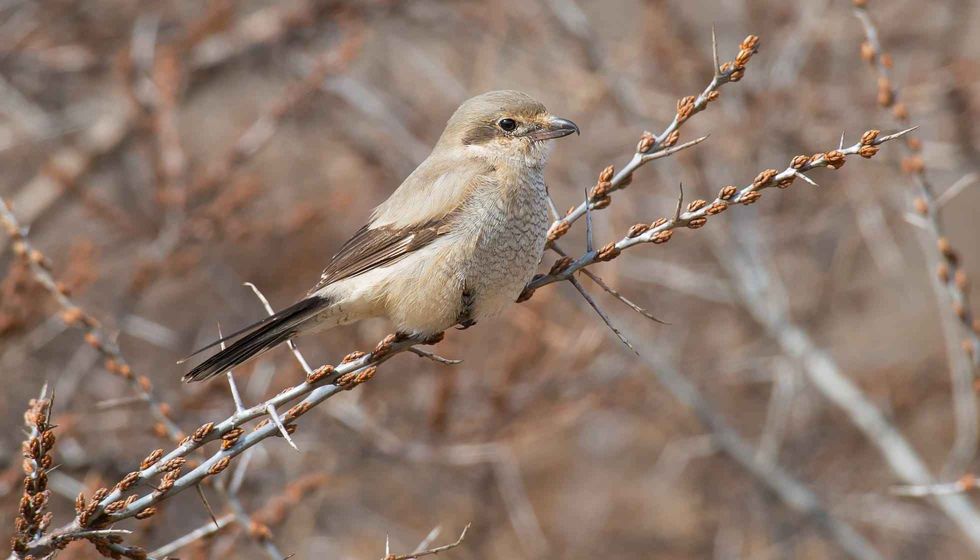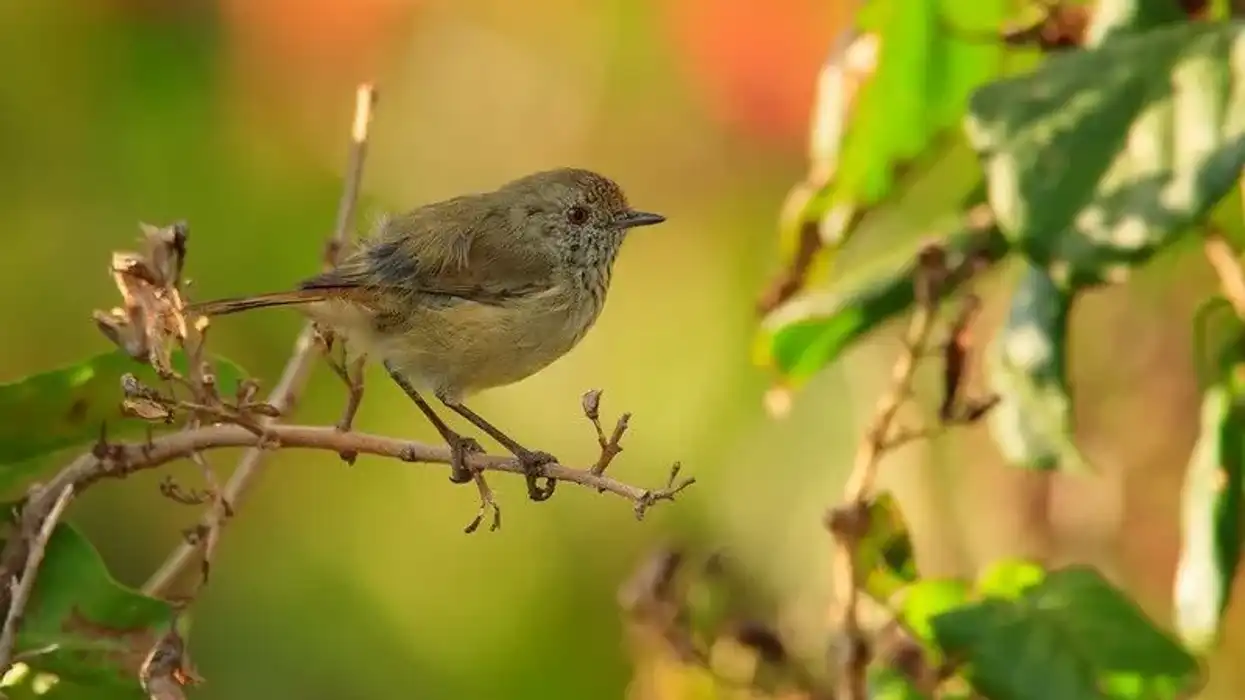Northern shrikes are predatory small birds found in the Northern Hemisphere. They are commonly found in regions of North America such as Alaska, Washington, and Canada.
They fly to the south of the United States during migration season. Besides the northern regions of America, this bird is also found in some parts of Asia and Europe.
Their hooked bills help them to tear the hunted animals' flesh, and they store this to be consumed later. Unlike other songbirds, these birds are purely carnivorous and are usually found hunting other animals.
A northern shrike (Lanius Borealis) can be seen sitting atop a barbed wire or a tree from where they scan the grounds for prey and pound on them as soon as they spot them. Younger birds are browner in color and become grayer and paler as they become adults. They share similarities with the loggerhead shrike bird.
To know more about these fascinating birds, take a look at some facts we have for you. You can also read our articles on the Humboldt penguin and macaroni penguin.
Northern Shrike Interesting Facts
What type of animal is a northern shrike?
These birds are among the songbird species in the family of shrikes.
What class of animal does a northern shrike belong to?
They belong to the Aves bird class of the animal kingdom.
How many northern shrikes are there in the world?
There are about six to nine identified sub-species of the northern shrike bird across the world. This bird of the north seems to have a stable population. However, accurate numbers are not available.
Where does a northern shrike live?
They live in semi-open forest lands and agricultural lands along the edges of savannah and tundra regions.
What is a northern shrike's habitat?
Their habitat differs in winter and breeding seasons. They can be found in the scrubs of country regions that are open to easily look for their prey.
These birds can be spotted in North American regions such as Alaska with scattered woods and alder scrubs during breeding. They create their nest along the edges of the tundra and also the edges of streams.
However, in the winter season, they are found in similar open areas, in high trees, and in perches of grasslands. They tend to nest and stay in the bushy areas of such lands.
They stay in the lower states only during the winter season. Migration happens during the summer season when they can be found in the southern parts of Alaska and Canada.
Who do northern shrikes live with?
These birds live with their type, the northern shrike (Lanius borealis). According to reports by the Cornell Lab of Ornithology, they co-exist with the North American loggerhead shrike, both belonging to the Passeriformes order of the Laniidae family.
How long does a northern shrike live?
They have a life expectancy of about four to six years. However, records reveal that the longest a northern shrike has lived is around eight years and seven months, and it was a female shrike.
How do they reproduce?
Northern shrikes tend to reproduce by forming monogamous pairs between male and female shrikes. Being territorial birds, they are known for defending their breeding lands during the summer season and their feeding grounds in the winter season.
They create their nest in concentrated conifer regions where females lay their eggs. Male shrikes try to attract female shrikes by trying to feed the female or singing songs to defend their territory and put up a hunting act. Once a female bird is ready to mate, they together build the nest.
It takes approximately 15 days for the eggs to hatch, and the family stays in the nest. Both parent shrikes feed and rear their young hatchlings.
What is their conservation status?
According to observations from the Cornell Lab of Ornithology, the conservation status of northern shrikes is not something to be concerned about. The birds are found in good numbers around the regions of North America. The IUCN, International Union for Conservation of Nature, has listed them as ‘Least Concern’.
Northern Shrike Fun Facts
What do northern shrikes look like?
Northern shrikes are the size of a pint and have a bull-head, being slightly larger than the other two shrike species of the north. Their size and wings help to identify them from other species.
They have pale gray fur underneath and darker black scales on their back. Northern shrikes have black wings and a tail with white patches.
Their face is marked by a black mark that stretches up to its hooked bill. It has a strong and flexible neck, and the neck and hooked bill together help it to hit its prey on hard surfaces and then tear at the flesh.
Males tend to have a more peculiar mark, while females tend to be browner. Younger shrikes are also brown and eventually develop gray and black scales and fur as they become adults.

*Please note that this is an image of a Great gray shrike, not a Northern Shrike. If you have a royalty-free image of a Northern Shrike please let us know at hello@kidadl.com
How cute are they?
Northern shrikes are cute songbirds. However, due to their predatory nature, some might not think of them as cute birds.
How do they communicate?
These are songbirds native to America, especially Alaska and Canada, and they sing throughout the year. Their communication methods include vocalizations by producing sounds similar to other birds and altering body positions by adjusting their wings and their food reserves.
These birds tend to mimic the songs and calls of birds of other species to lure their prey. Once they have attracted their prey, they pounce and kill it.
How big is a northern shrike?
They are medium-sized birds with an approximate length of 9.0-9.5 in (22-25 cm). The wingspan is about 11.8-13.3 in (30-34 cm). Their round pint-sized body makes them about six times bigger than hummingbirds. However, they are smaller than birds such as magpies and crows which are common threats to birds of similar species of the shrike family.
How fast can a northern shrike fly?
The northern shrike's wingspan helps them to create a sort of 'flashing' wing movement.
How much does a northern shrike weigh?
They weigh between 1.8-3.0 oz (50-76 g).
What are the male and female names of the species?
There are no such distinct names given to them in terms of gender.
What would you call a baby northern shrike?
There are no specific terms for a baby northern shrike.
What do they eat?
Shrike birds feed on snakes, vertebrates, lizards, and large insects. The birds also eat vertebrates and have been observed to consume lubber grasshoppers extensively. However, they are not categorized as birds of prey.
How aggressive are northern shrikes?
They are extremely aggressive birds and are known to kill their prey brutally. They are skilled at spotting their prey from high altitudes such as long treetops and barbed wire and pounce on them to swiftly catch their target and kill them with strong reflexes in their neck and sharp bill.
Is a northern shrike more aggressive than a loggerhead?
Although both belong to similar species and are similar in hunting and killing tendencies, the loggerhead shrike is found to be more aggressive among the two.
Did you know...
The term 'Lanius excubitor' translates as 'butcher watchman.'
Males of this species tend to sing more during the later winter season and early spring season.
How many songs can a northern shrike sing?
Northern shrikes are famous for singing a variety of songs throughout the year. They sing and produce as many as six to seven different sounds and calls. Some of these include warning sounds or calls, alarming sounds, calls for submission, calls for courtship, and calls to attract prey.
How many eggs does a northern shrike lay?
They are known to lay about four to seven eggs in one clutch.
Here at Kidadl, we have carefully created lots of interesting family-friendly animal facts for everyone to discover! Learn more about some other birds, including shrike or red-bellied woodpeckers.
You can even occupy yourself at home by drawing one on our Northern Shrike coloring pages.










